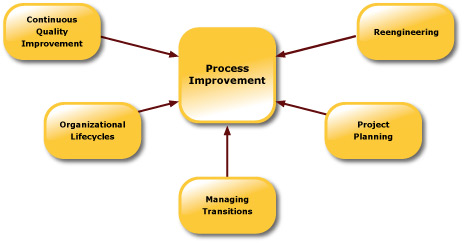Change Management Theories
There are five business theories that, when combined, produce a powerful process improvement effort:
What are these “theories”, and what are the pitfalls of not including one in your own change initiatives? Let’s take each of them one at a time.
Continuous Quality Improvement:
CQI is the largely based on the work of W. Edwards Deming and Joseph Juran. They utilized statistical analysis to discover what is happening in a system. Emphasis for improvement is on removing waste and rework by streamlining the system in such a way that it delivers a quality product each time. Deming stated that well over 90% of the problems in an organization are the result of faulty systems, that employees overall want to do a good job. When systems or processes are improved using the CQI tools and techniques, employees are able to excel, customers are satisfied and costs reduced.
What’s the pitfall of not incorporating CQI well? Poor data gathering. Good customer data and system data is essential for buy in of both staff and leadership. Knowing your baseline is essential to assess whether your improvements are working, paying for themselves and building support amongst the troops. For more on gathering data, visit our past newsletter article on the importance of data
Organizational Lifecycles:
Organizational Lifecycles, as we apply them here at PGS, are based on the work of Ichak Adizes in his book Corporate Lifecycles and Jerry Faust, who created a template to assess the stage an organization is in in its lifecycle. In the context of process Improvement or change management, the key is to have the optimal mix of flexibility vs control in the organization. During a change initiative, it is key to maintain an on-going assessment of when more flexibility from leadership is needed vs more control.
What’s the pitfall of not understanding organizational lifecycles? Just as asking a young child to drive your car is ill advised, asking an organization at one stage of the lifecycle to act as though it is at another is risky. If the organization is in a go-go mode, asking it to slow down and clearly flow systems is an impossible task. Likewise, an old bureaucratic organization will find it hard to be innovative. For a successful change initiative to stick, leadership must be understand how to approach systems and innovation correctly within their organization’s culture. Without that step, they will fall back on old ways quickly and the change effort will likely fail.
Managing Transitions:
Employee transitions are probably the most overlooked piece of the change management puzzle, and the reason many change initiatives fail. Managing Transitions is based on the work of William Bridges and focuses on the people side of change. Emphasizing the what the employees are dealing with in change, both positive and negative, and how their reactions can make or break the process is critical, as is developing a plan to help transition employees impacted by the change successfully through it.
What’s the pitfall of not managing transitions? Disaster! Truly managing the people side of change is critical to change management success. It is human nature to resist or even fear change. Regardless of whether the change is perceived as positive or negative. Coaching staff through the change process is essential to its success. For more on transitions, click here.
Project Management:
Here is another spot where many change initiatives fail. Management can identify the need for change and create a new system, even address transitions impacting employees. But unless all that detail is laid out in a clear, visual roadmap of activity that takes the organization from its current process to the new one, it becomes a jumbled mess of starts and stops. Project management organizes the work defined into clear, coordinated tracks of activity, helping to assure the steps needed to complete the change initiative are completed.
What’s the pitfall of not using project planning? The pitfalls of not using a good project planning method to map out the work range on a scale from poor time management and discouraged staff on one end to project chaos and complete loss of momentum on the other. Project planning is critical to maintaining consistent progress, achieving early successes and staying organized throughout – delivering the new process in the least amount of time with the least expense possible. We have discussed sound project management skills here.
Reengineering:
“Business Process Reengineering” was coined by Michael Hammer in the early 1990’s. Though reengineering often became associated with layoffs and cutbacks, the tools and theory were not initially designed with that in mind. Reengineering brings to change initiatives the tools to analyze a process, brainstorm new designs, test and roll-out. It is a fundamental component of good change management. Reengineering means “a radical change in the way we work producing a dramatic improvement in performance”. This often gives the big breakthroughs like an app for customers to shop without coming in the store.
What’s the pitfall of not using reengineering theory? Processes may not be redesigned to successfully eliminate the rubs and rework in the system that are creating problems for the customers and employees. Reengineering brings the discipline to map current processes, identify these rubs and redesign the process to eliminate them in the long term.
What does the combination of change management theories look like?
Professional Growth Systems’ Process Advantage has integrated the above change management theories into a cohesive package. To find out more about Process Advantage click here. If you would like to talk with a consultant about your organization and if it is ready to take on a change initiative, contact us via e-mail or by phone at (877) 276-4414.


